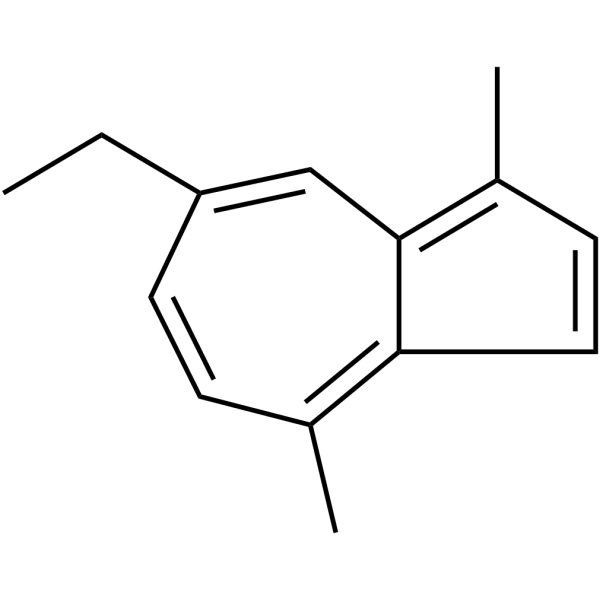Chamazulene

Chamazulene structure
|
Common Name | Chamazulene | ||
|---|---|---|---|---|
| CAS Number | 529-05-5 | Molecular Weight | 184.277 | |
| Density | 1.0±0.1 g/cm3 | Boiling Point | 299.1±20.0 °C at 760 mmHg | |
| Molecular Formula | C14H16 | Melting Point | <25℃ | |
| MSDS | Chinese USA | Flash Point | 137.4±12.5 °C | |
|
Rapid evaluation and comparison of natural products and antioxidant activity in calendula, feverfew, and German chamomile extracts.
J. Chromatogr. A. 1385 , 103-10, (2015) The present study describes a simple high performance thin layer chromatographic (HPTLC) method for the simultaneous quantification of apigenin, chamazulene, bisabolol and the use of DPPH free radical as a post-chromatographic derivatization agent to compare ... |
|
|
Chamazulene: an antioxidant-type inhibitor of leukotriene B4 formation.
Planta Med. 60(5) , 410-3, (1994) Matricine and its transformation product chamazulene are constituents of chamomile extracts. Both have been demonstrated to exert anti-inflammatory activity in vivo. Since preparations from chamomile are used for the treatment of inflammatory skin and bowel d... |
|
|
[Pharmacologic studies on chamomile compounds. VI. Studies on the antiphlogistic effect of chamazulene and matricine].
Planta Med. 49(2) , 67-73, (1983)
|
|
|
Absolute stereochemistry of guaianolides, of matricin and its epimers, of yarrow proazulenes, and of chamazulene carboxylic acid.
Chirality 13(7) , 337-41, (2001) Known determinations of the absolute configuration of guaianolides were collected and found to be few. The absolute configurations of guaianolides rest on the assumption that 7-H always has alpha-orientation. For matricin, only the relative configuration was ... |
|
|
Activity of Matricaria chamomilla essential oil against anisakiasis.
Phytomedicine 19(6) , 520-3, (2012) The increase in diagnosed cases of anisakiasis and the virtual absence of effective treatments have prompted the search for new active compounds against Anisakis L(3) larvae. The biocidal efficacy against different pathogens shown by various essential oils (E... |
|
|
Screening of chemical composition and antifungal and antioxidant activities of the essential oils from three Turkish artemisia species.
J. Agric. Food Chem. 53(5) , 1408-16, (2005) The compositions of essential oils isolated from the aerial parts of Artemisia absinthium, Artemisia santonicum, and Artemisia spicigera by hydrodistillation were analyzed by GC-MS, and a total of 204 components were identified. The major components of these ... |
|
|
Investigation of the effect of chamazulene on lipid peroxidation and free radical processes.
Res. Commun. Mol. Pathol. Pharmacol. 92(3) , 361-4, (1996) Oxygen toxicity and related free radical reactions are implicated in numerous pathophysiological conditions, like atherosclerosis, inflammation, gastric ulceration, neuronal degeneration, tumour promotion. The flowers of Matricaria chamomilla, Asteraceae, hav... |
|
|
Trypanosoma cruzi: activity of essential oils from Achillea millefolium L., Syzygium aromaticum L. and Ocimum basilicum L. on epimastigotes and trypomastigotes.
Exp. Parasitol. 116(3) , 283-90, (2007) Trypanocidal activity of clove (Syzygium aromaticum L.), basil (Ocimum basilicum L.) and yarrow (Achillea millefolium L.) essential oils and some of their constituents (eugenol and linalool) was investigated on Trypanosoma cruzi epimastigote and bloodstream t... |
|
|
Management of oral mucositis during local radiation and systemic chemotherapy: a study of 98 patients.
J. Prosthet. Dent. 66(3) , 361-9, (1991) Oral mucositis is among the complications of head and neck irradiation and systemic chemotherapy. To determine whether or not mucositis could be prevented or reduced in intensity by using Kamillosan Liquidum as an oral rinse, 98 patients were placed on study ... |
|
|
Phytochemical analysis of the essential oil of Achillea millefolium L. from various European Countries.
Nat. Prod. Res. 20(12) , 1082-8, (2006) Variations in the essential oil composition of Achillea millefolium L. growing in Estonia and in other European countries, were determined. The oils were obtained in yields of 0.9-9.5 mL kg-1. A total of 102 components were identified. The quantitatively most... |